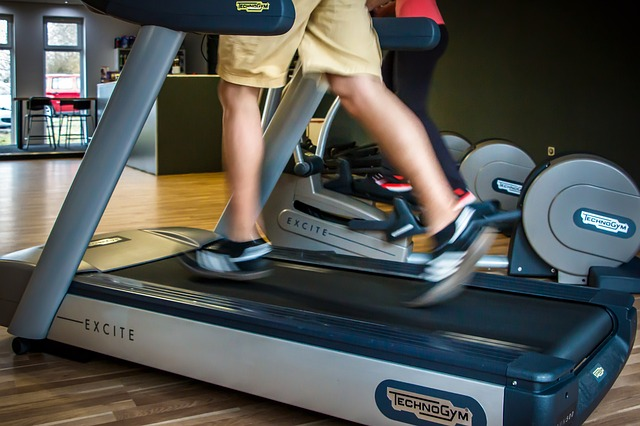Too much friction, tension, drive belt, etc., are the prime reasons that can cause treadmill belt slippage. Adjusting the tension in the belt can help fix it. A stomp test on the front roller is a popular way of testing and repairing resistance. Could you keep reading to know the reasons for slippage in detail and how to prevent treadmill belt slipping?
5 Reasons Why Your Treadmill Belts Might Be Slipping
1. Treadmill Belts Need lubrication
If it is gym equipment, it needs enough lubrication. No two ways exist, no matter what the advertisement and owner’s manual say. To understand this issue of slipping the treadmill belt, we first need to check out its basic design.
First, a running deck is covered with a running belt dressing. This is then attached to the front and rear roller bearings that help the belt constantly rotate, allowing a free walk or run.
As time passes, the initial lubrication and smoothness eventually fade away, resulting in too much friction. This, in turn, causes the treadmill belt slippage, thereby hindering the workout experience. Experts believe that the primary reason here is the ‘no maintenance’ charade put forth by equipment companies as a sale pitch.
Now that we have understood the issue, it is time for a permanent solution. We all know that sending a treadmill to the shop for repair is quite a hectic task because of its size and weight.
Hence, the best course of action is to find a compatible lubricant that can be used at home. In most cases, checking out the owner’s manual for plausible options is always best. However, for others, a silicone-based lubricant should do the trick.

2. Worn or Loose Drive Belt
A worn-out or loose drive belt is the next major issue that might cause slipping treadmill belts.
Firstly, let us see what a drive belt dressing means. This belt strip helps join the front roller to the motors underneath the hood cover. Luckily, even though all of this sounds very technical, checking for a worn-out belt is relatively easy,
You can start by turning on the machine and stepping on the moving surface. If the engine is still working, but the walking belt is not moving, it is a case of a worn-out belt. In most instances, it is a natural outcome of the continuous wear and tear caused by friction of the motors.
There are two solutions to this problem. Firstly, you can either go through the user manual and DIY videos for ways of tightening the loose drive belt dressing.
While this process seems pocket friendly initially, the major drawback is that it can put excess pressure on the motor causing it to fail and burn out over time. On the other hand, you can consult an authorized service center and go for a new belt.
This is considered the best fix as it aids the machine in running the belt seam smoothly and gives the best workout experience.
3. The Pulley on The Front Roller May Have Lost its Grip
A loose pulley is next on the list of reasons for a slipping treadmill belt. The pulley is the mediator between the walking belt and the front roller. It pulls the belt from the top, making it roll over the front rollers and complete the entire operating cycle.
Therefore, in the case of a slipping belt, there is a high chance that the pulley must have worn out and lost its grip, causing misalignment between the two. This can mainly be seen in cases of cheap treadmills and one’s without professional maintenance of any sort.
Here is what you have to do to find out if a loose pulley is making your treadmill slip. Start by turning the machine off. Then take a strip of colored tape or paper and stick one end on the visible section of the pulley and the other on the roller’s metal tube.
Or you can also take two separate strips, stick them on the pulley and the driving roller, and make sure they align. Apart from these two methods, drawing a straight line with a marker from the pulley to the roller tube will also do.
Now, start the machine and stop once you see the belt slipping. If the sticker or marker line on the pulley is not aligned with that on the front roller or walking belt, or if the strip of paper has torn, they are no longer moving in coordination.
This can only mean that the pulley has lost its grip and needs an immediate fix. On the off chance that the sticker or line stays intake, it means that the pulley is not at fault and something else is the cause for the slipping belt.
The only viable solutions for this problem are to repair the pulley or install a new front roller. Either way, it is not a do-it-yourself task, and it will be best to hire a technician.
4. Walking Belt May Be Too Lose
If you have considered the drive belt and still cannot find the issue, it is time to scrutinize the walking or running belt. When you buy a new treadmill, the running belt is attached to the top of the running deck.
This is a moving surface that you step on and start your workout. So naturally, if it does not press fit right and has enough elasticity, there are bound to be accidents.
Here’s what you should do to analyze if the treadmill slipping problem is caused by the walking or running belt. Go to the off-center and shut down the machine. Once the belt stops running altogether, try to lift the middle segment.
According to experts and user manuals, if the belt comes off around 2 to 3 inches, then there is no problem. However, if it lifts off more, it is safe to assume that it is causing the treadmill belt slippage.

Find your owner’s manual, read through it, and determine how much to tighten the belt. You can even browse through the troubleshooting tips available on the web.
However, one of the biggest mistakes made by owners is that they tend over tighten the belt sometimes. This, in turn, runs the risk of motor damage and loud noise due to too much friction. Lucky for you, this is not severe and can be quickly handled.
Moreover, it can also result in belt tension, making it wear out faster than usual. Thus, considering all these factors, it is best to contact an authorized service center and ask for help to prevent unnecessary damage to expensive treadmills.
5. The Tension Bolt Pulling Through a Plastic End Cap
It is no secret that different treadmills are available in the market. Depending on the price range, some are put together with plastic parts, while others use metal. Now, this difference has an impact on the longevity of the treadmills. Let’s keep that thought aside for a moment.
Did you know that when a walking belt slips, you can align or tension it using rear roller bolts and wrenches? Sounds easy, right? You have to go to the right side of the first rear roller bearings and peep through the pilot hole to see what type of tension bolt is used.
These bolts have essentially two types of heads: Allen wrench head and Hex wrench head. Once you have spotted that, find the metal kit supplied along with the treadmill and pick the correct wrench.
Start turning the bolt clockwise or anti-clockwise, depending on whether you need to tighten or loosen the belt.
Now, remember we talked about plastic parts? This is where it comes into play. If plastic parts are used to create the end cap instead of metal ones and to put together and tighten the walking belt, then there is a high chance that the tension bolt has pulled through it.
The two primary reasons for the plastic end cap to break are wear and tear and repeated heating up of the treadmill during workouts. Either way, no matter how much you try, the belt tension will not be sufficient, causing slippages.
How do you fix common treadmill problems?
1. Treadmill Belts Slipping:
The issue of Drive belt slippage can happen to almost every treadmill after a few years of purchase. The easiest fix is to align the loose treadmill belt over the running deck and tighten the bolts in a clockwise manner using the Allen wrench.
Ensure not to over-tighten the bolts, as that may lead to too much friction. A 2 to 3 inches gap means it’s perfectly fitted.

2. Heated Belt:
If you are a regular user, then by now, you must have noticed that treadmill belts get heated up sometimes during a workout. Too much heat can lead to sudden shutdowns or the running belt seam coming off.
If this problem starts to occur more frequently, then there is a chance the lubrication has dried up, causing friction and a heated-up feeling.
You have to let the machine cool down and apply the appropriate lubricant. If it still does not help, you must replace the belt.
3. Erratic Speed:
There can be different causes and appropriate fixes for inconsistent speed. First is the issue of inadequate operating amps or faulty circuits. Most treadmills run on 20 amp. Any fluctuation in electricity can cause variable rates and, therefore, must be fixed. The second is a deteriorated motor or treadmill belt.
Lastly, the varying speed can also be caused due to changes in settings. In this case, getting a new part is the wisest option if the warranty period is over. Just pull out the owner’s manual and flip to the segment, which discusses the recommended speed limit and how to set it.
4. Broken Motor:
Like every other machine, a treadmill motor will also wear down regularly when used at full speed. This is another problem that can appear out of the blue, especially for treadmills that have provided service for years. The only fix is to replace the part to avoid safety issues.
5. Burning Smell:
This is a common problem outcome in rigorously used machines without proper maintenance. Lack of adequate lubrication can lead to friction and thereby cause a burning smell. The burning smell can result from faulty wiring, in which case you need an electrician immediately.
The next alternative is complete wear and tear of the motor, front, or rear roller, requiring a professional technician.
FAQ
What causes a treadmill belt to slip?
Following are some of the primary reasons: Lack of lubrication, Worn-out drive belt, Need for a new pulley or front roller, Over tightening of the walking belt, Lose walking belt, etc.
How do I stop my treadmill belt from slipping?
You can find the roller bolts on the left and right sides of the end cap and see what type of wrench head it has: Allen wrench or hex key. Then pick the appropriate one and start turning the bolts clockwise. Keep checking the belt after every turn to ensure the best results.
How tight should a treadmill belt be?
If the belt rises 2 to 3 inches, it is perfectly okay. If it does not go as high as that, it may have over-tightened, and if it exceeds the limit, it means it is loose.
Is it normal for the treadmill belt to move?
While it is not normal for a treadmill belt to move, it is a common reason in machines that have been used for quite some time. This repeated walking or running action may cause the belt to move away from the center.
What does a slipping treadmill belt feel like?
If a treadmill belt slips, you will feel an uneasiness under your foot, like you are about to fall. This happens every time you plant your feet during a walk or a run. Moreover, if the feeling is left unattended without a fix for a long time, it can eventually result in accidents.
How do I know if the treadmill belt is slipping too loose?
If you find that the treadmill belt is slipping, then there is a chance it is too loose. The only viable way to know for sure is to turn the machine off and lift the middle segment of the belt from one side. If the belt rises more than 2 to 3 inches, the belt slips tension is too loose.
What is the Average Lifespan of a treadmill?
As per expert manufacturers, the average lifespan of treadmills is around ten years. Nevertheless, if you have an authorized service center handy and lubricate your treadmill belt regularly, it shall last longer. Just remember to keep an eye out for frayed edges and failing motors, which would need a fix after a decade has passed by.
Is it worth repairing a treadmill?
Yes, it is worth repairing a treadmill’s worn-out parts rather than buying a new one. A treadmill is costly gym equipment and, for most people, is a one-time investment.


